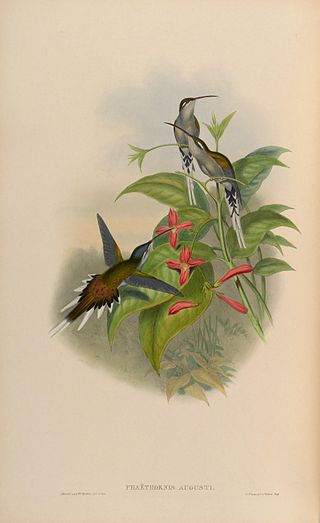
The sooty-capped hermit is a species of bird in the family Trochilidae, the hummingbirds. It is found in Brazil, Colombia, French Guiana, Guyana, Suriname, and Venezuela.

Phaethornis is a genus of hummingbirds in the hermit subfamily, Phaethornithinae. They occur from southern Mexico, through Central America, to South America as far south as northern Argentina.

The long-billed hermit is a bird in the family Trochilidae, the hummingbirds. It is found from central Mexico south through Central America, Colombia and Ecuador into Peru.

Humboldt's sapphire or Humboldt's hummingbird is a species of hummingbird in the "emeralds", tribe Trochilini of subfamily Trochilinae. It is found in Colombia, Ecuador, and Panama.

The black-throated hermit is a species of hummingbird in the family Trochilidae. It is found in Colombia, Ecuador, and Peru.

The straight-billed hermit is a species of bird in the family Trochilidae, the hummingbirds. It is found in Brazil, Colombia, Ecuador, French Guiana, Guyana, Peru, Suriname, and Venezuela.

The scale-throated hermit is a species in the hummingbird family Trochilidae. It is found in Argentina, Brazil, and Paraguay.

The grey-chinned hermit is a species of hummingbird in the family Trochilidae. It is found in Brazil, Colombia, Ecuador, Peru, and Venezuela.

The white-bearded hermit is a species of hummingbird in the family Trochilidae. It is found in Bolivia, Brazil, Colombia, Ecuador, Peru, and Venezuela.
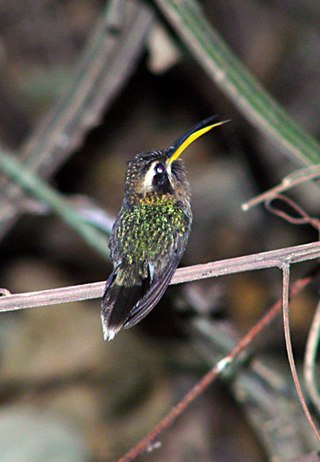
The minute hermit is a tiny species of hummingbird in the family Trochilidae. It is endemic to Brazil.

The great-billed hermit is a species of hummingbird in the family Trochilidae. It is found in Bolivia, Brazil, Colombia, Ecuador, French Guiana, Peru, Suriname, and Venezuela.

The needle-billed hermit is a species of hummingbird in the family Trochilidae. It is found in Bolivia, Brazil, and Peru.

The reddish hermit is a species of bird in the family Trochilidae, the hummingbirds. It is found in Bolivia, Brazil, Colombia, Ecuador, Peru, Venezuela, and the Guianas.

The streak-throated hermit, also known as the Rupurumi hermit, is a species of hummingbird in the family Trochilidae. It is found in Brazil, Colombia, Guyana, and Venezuela.
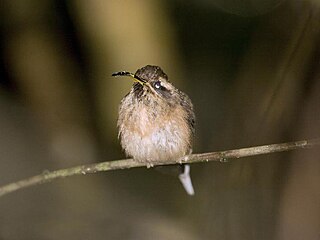
The dusky-throated hermit is a species of hummingbird in the family Trochilidae. It is endemic to Brazil.
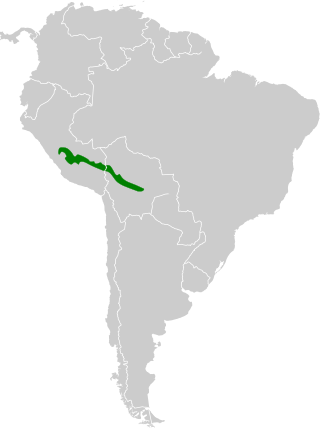
The white-browed hermit is a species of hummingbird in the family Trochilidae. It is found in the Andean foothills and adjacent lowlands in Bolivia and Peru. Its natural habitat is subtropical or tropical moist lowland forest.

The sooty barbthroat is a hummingbird species in the family Trochilidae. It is found in Brazil and French Guiana.

The planalto hermit is a species of bird in the family Trochilidae, the hummingbirds. It is found in Argentina, Bolivia, Brazil, Paraguay, and Peru.
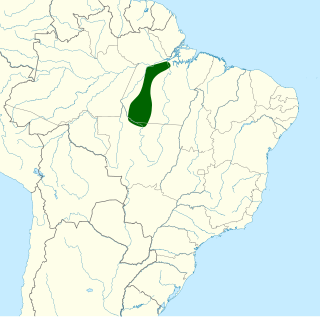
The Tapajós hermit is a species of hummingbird in the family Trochilidae. It is endemic to Brazil.

The Mexican hermit is a species of hummingbird in the family Trochilidae. It is endemic to Mexico.























